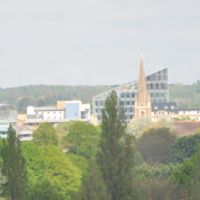Fuller Long have been granted planning permission on behalf of our client for a replacement dwelling in Weybridge. The property was located in the Green Belt and thus, according to the Government’s policy restriction, any new dwelling should not be materially larger than the one it replaces. Fuller Long advised the client that when submitting any planning application of this kind, it must be supported by a design and access statement and possibly a bat survey and/or tree survey.
Furthermore, when submitting the application, Fuller Long also conducted a Flood Risk Assessment (FRA). The assessment proved that, given the location of the site adjacent to the River Wey within Flood Zone 2, it was at risk of flooding from the river. However, the Environmental Assessment mapping confirmed that the risk from the ‘surface water’ flooding was “very low” and that flooding from reservoirs would be “extremely unlikely to happen.”
The existing house on site had a footprint of 64sqm and an outbuilding which measured 26 sqm, both of which were at ground level. These two buildings were proposed to be removed and replaced with a single building providing a three bedroom dwelling. The replacement house was to be raised with ‘voids’ beneath to facilitate the free flow of water. This would mean that there would be no flood compensation storage required. Fuller Long, in addition to aiding the planning application for this development, submitted a separate Building Regulation Application.
Fuller Long also submitted a Certificate of Existing Lawful Development in order to further aid the planning application for the aforementioned property. The Certificate of Existing Lawful Development clearly outlined that the property had been purchased in 1980. The LDC further proved that the layout of the house as completed, had existed up until the planning application was submitted. This comprised a bathroom, kitchen, living area, bedroom, rear hall and front porch. Fuller Long were also able to prove residency of the property from 1980 to 2016.
Case law has determined that the consideration of whether a building comprises an independent dwelling relies on two matters. First, whether the accommodation enables the building to be occupied as an independent dwelling. It was clear that this was the case in this instance. The second is how the building has been occupied. In relation to this claim, Fuller Long, through the declaration, were able to clearly demonstrate that the house had been occupied continuously as an independent residential dwelling in excess of 30 years.
Fuller Long finally argued that within the Planning Practice Guidance Notes, it is stated that “In the case of applications for existing use, if a local planning authority has no evidence itself, nor any from others, to contradict or otherwise make the applicant’s version of events less than probable, there is no good reason to refuse the application, provided the applicant’s evidence alone is sufficiently precise and unambiguous to justify the grant of a certificate on the balance of probability”. Thus, the declaration from Fuller Long in conjunction with aerial photographs and correspondence from long standing local residents, was granted.
In doing so, Fuller Long were able to grant full planning permission for the property and development was able to commence.
To discuss a planning issue in regards to the Green Belt with one of our experienced team of consultants, please call us on 0808 164 1288 for a no obligation conversation or email us at hello@fullerlong.com





